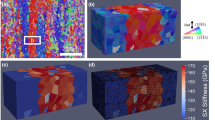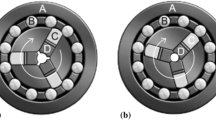Abstract
Titanium intermetallics are being developed for long term applications at elevated temperatures, particularly those alloys based on the alloys Ti3Al and TiAl. Typical approaches include the design of appropriate microstructures for room and elevated temperature fatigue and creep resistance. However, a little explored area is the stability of these microstructures at elevated temperature and its effect on fatigue crack growth. The present investigation documented the microstructural stability, fatigue crack behaviour, and stress rupture of Ti-24Al-11Nb, a Nb modified Ti3Al alloy. A coarse two phase α2+β Widmanstatten microstructure was found to exhibit the best resistance to fatigue crack growth. Microstructural stability and elemental segregation were studied as a function of exposure time for up to 500 h at 800°C using transmission electron microscopy (TEM). Results indicate that the Widmanstatten microstructure is metastable and the β phase breaks up into particles. The absence of a continuous β phase surrounding the α2 phase reduces the resistance of the microstructure to fatigue crack growth at room temperature. At elevated temperature the microstructure stability does not play a role in determining the fatigue resistance. A fine Widmanstatten microstructure has the best resistance to creep deformation. Stress rupture tests were conducted in vacuum and air at 649°C and 760°C. Two types of failure mechanisms were seen in stress rupture; these include transgranular and intergranular failure within prior β grains. When tested in air at 760°C a combination of transgranular and intergranular failure occurred. Specimens that exhibited a higher proportion of transgranular failure had longer lives. When tested in vacuum at 760°C the predominant failure mode was intergranular. At 760°C extensive microstructural changes like breakup and spherodization of the β phase occurred under stress while the rate of coarsening without any stress was much slower. At 649°C the specimens tested in vacuum consistently exhibited longer lives. The creep crack growth when tested in air at 649°C was always a brittle transgranular mode while the specimens tested in vacuum always failed by an intergranular mode.
Similar content being viewed by others
References
S. M. L. SASTRY and H. A. LIPSITT, Metall. Trans. A 8 (1977) 299.
Idem., ibid. 8 (1977) 1543.
Idem., Acta Metall. 25 (1977) 1279.
H. A. LIPSITT, D. SHECHTMAN, and R. E. SCHAFRIK, Metall. Trans. A 11 (1980) 1369.
R. J. KERANS, Idem. 15 (1984) 1721.
R. G. ROWE, High Temperature Aluminides and Intermetallics., Sym. Proc., October 1–5, 1989, Indianapolis edited, S. H. Whang, C. T. Liu and D. P. Pope and J. O. Stiegler, TMS-AIME, (Pittsburg, PA, 1990) p. 460.
Y.-W. KIM and F. H. FROES, Ibid, p. 485.
P. B. ASWATH and S. SURESH, Materials Science and Engg. A114 (1989) L5–L10.
P. B. ASWATH, W. O. SOBOYEJO and S. SURESH, Fatigue '90 edited H. Kitagawa and T. Tanaka, eds., (Materials and Components Engineering Publications, Ltd., Warley, U.K., Vol. III, ( Honolulu, Hawaii, July 15–20, 1990)) pp. 1941–1946.
P. B. ASWATH and S. SURESH, Elevated Temperature Crack Growth, edited by S. Mall and T. Nicholas., ASME Winter Annual Meeting, Dallas, Nov. 25–30, (ASME, New York, 1990), pp. 69–77.
P. B. ASWATH, "Micromechanics of Quasi-Static and Fatigue Crack Growth in Titanium Aluminides", Ph.D. Thesis, Brown University, (1990).
P. B. ASWATH and S. SURESH, Metall. Trans. A. 22 (1991), 817.
D. BANERJEE, A. K. GOGIA, T. K. NANDI and V. A. JOSHI, Acta Metall. 36 (1988) 36.
S. SURESH, Engg. Fracture. Mechanics. 21 (1985) 453.
R. STRYCHOR, J. C. WILLIAMS and W. A. SOFFA, Metall. Trans. A 19 (1988) 225.
D. BANERJEE, A. K. GORGIA and T. K. NANDY, Ibid. 21 (1990) 627.
S. SURESH, Ibid. 14 (1983) 2375.
Idem. ibid. 16 (1985) 249.
D. L. DAVIDSON, K. S. CHAN and J. LANKFORD, "Crack Growth Processes at Elevated Temperatures in Advanced Materials", AFOSR Annual Report for 1989, under contract F49620-89-C-0032, January, 1990.
S. J. BALSONE, T. NICHOLAS, D. C. MAXWELL and M. KHOBAIB, Elevated Temperature Crack Growth. edited by T. Nicholas and S. Mall (ASME., New York, NY, (1990)) pp. 87–91.
S. MALL, T. NICHOLAS, D. G. BURGESS, and J. J. PERNOT, Engg. Fract. Mech. (submitted).
W. O. SOBEYEJO, J. E. DEFFEYES and P. B. ASWATH, Mat. Sci. and Engg. A 138 (1991) 95.
H. MARGOLIN, Met. Trans. A 13 (1982) 2191.
S. J. BALSONE, Oxidation of High Temperature Intermetallics, edited by J. Doychak and T. Grobstein, (TMS-AIME (1988)) pp. 219–234.
J. HALL, Ibid. pp. 235–240.
Author information
Authors and Affiliations
Rights and permissions
About this article
Cite this article
ASWATH, P.B., GOOLSBY, R.D. & GRAHAM, L.W. Microstructural stability and mechanisms of fatigue and creep crack growth in Ti–24Al–11Nb. Journal of Materials Science 32, 2191–2206 (1997). https://doi.org/10.1023/A:1018551611904
Published:
Issue Date:
DOI: https://doi.org/10.1023/A:1018551611904




